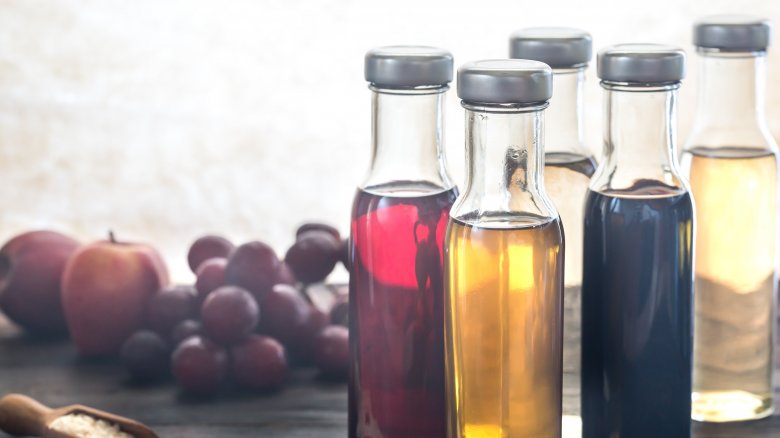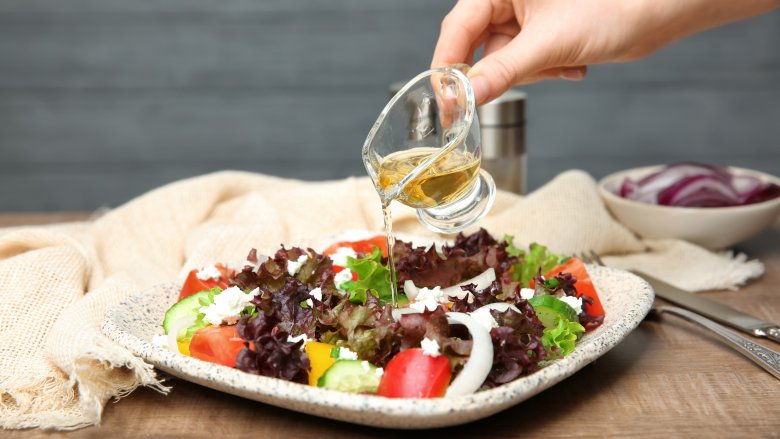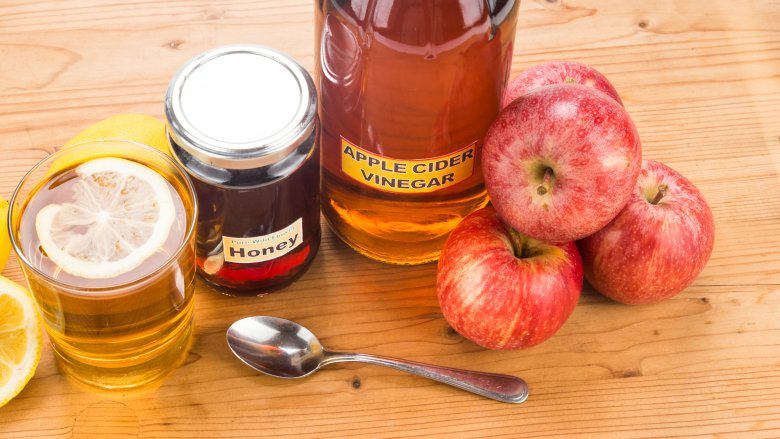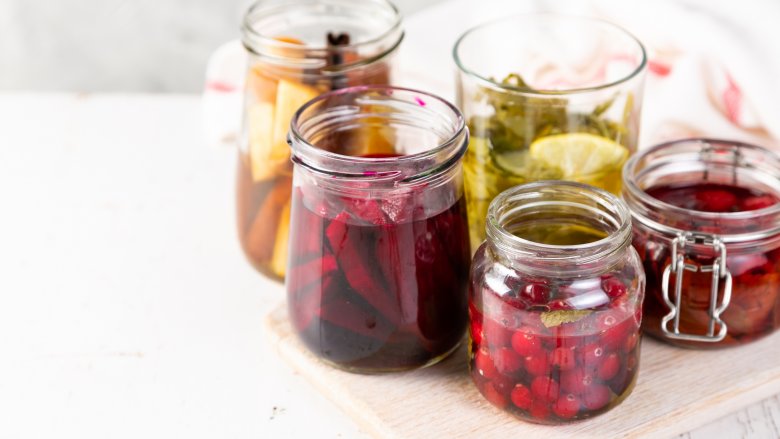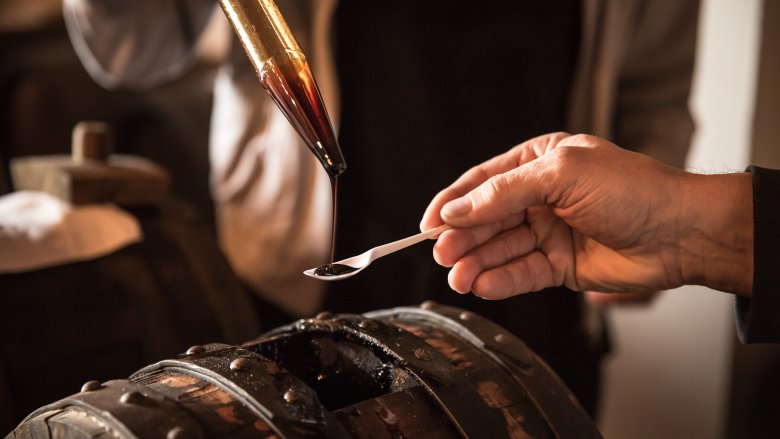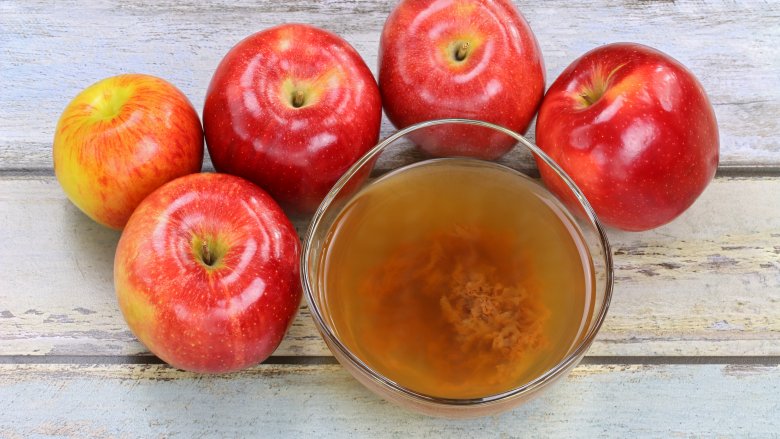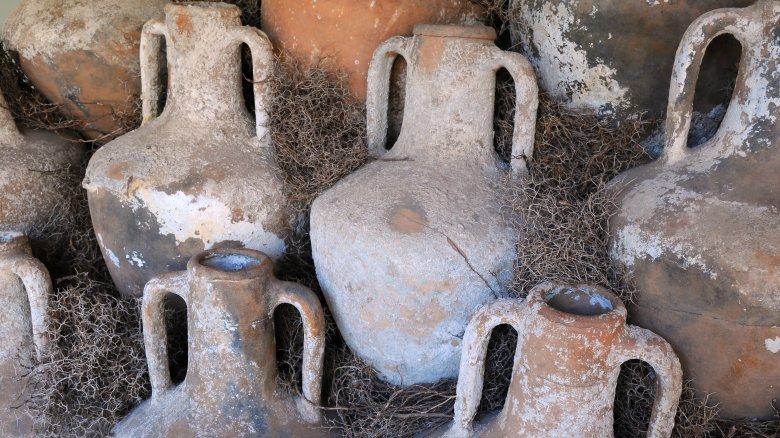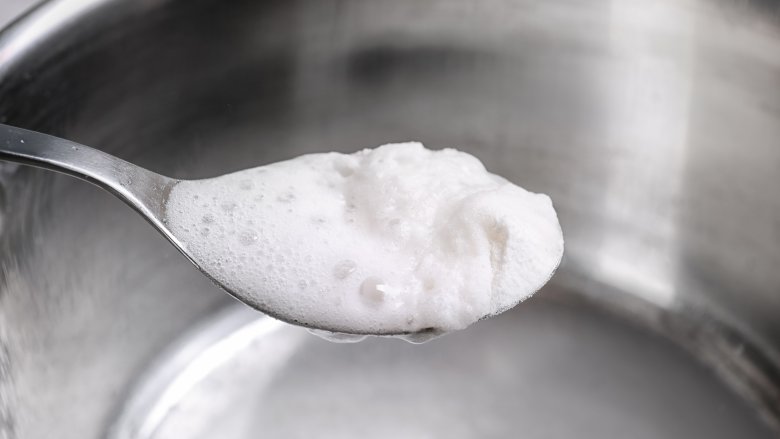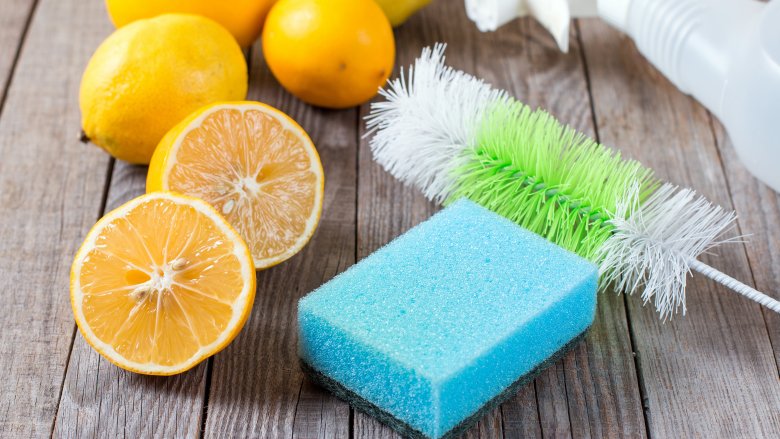The Untold Truth Of Vinegar
Like so many other items you'll find rattling around in your kitchen cupboards, vinegar is one of those things most people are aware of — without paying much attention to what it actually is. And frankly, why would you? Sure, it's a pretty useful tool, but it's not much else... right?
Wrong. Despite being so innocuous that you'd honestly struggle to even define it, vinegar is a fascinating mainstay in the home, both inside and outside the kitchen. Its history stretches back thousands of years, it comes in a near countless number of varieties, it's hugely useful for cooking, mostly useful for household cleaning (it even does something pretty cool when you put it in your toilet), and it's good for a party trick or two. Sure, it's hardly glamorous, but who needs glamour when you've got a solution of water and acetic acid to hand? Nobody, that's who. Buckle up, folks — it's time to dive into the world of vinegar.
There are many different vinegars
Although it's easy to use the word "vinegar" as some kind of all-encompassing term, the truth is that there are all kinds of different vinegars, each with their own tastes and uses. Let's run through some of the most popular.
First, you've got distilled white vinegar; the kind you probably have sitting in your kitchen right now. This stuff is made from pure ethanol and is as useful in cooking as it is as a cleaning agent. Red wine vinegar has a variety of uses, including vinaigrette, dressings, marinades and strong, rich sauces. White wine vinegar, meanwhile, is far more fruity and lends itself to light sauces, vinaigrettes and pickling. (If you're feeling particularly bourgeois, you could always opt for Champagne vinegar, which is basically white wine vinegar but far stronger in flavor.)
You probably have a bottle of balsamic vinegar sitting around somewhere, too. This is made directly from fermented grapes, rather than wine, and goes great with olive oil, bread and salads. Less common is rice vinegar, made from rice wine, which is sweeter than most vinegars and goes great with fish marinades and sushi rice. Apple cider vinegar is said to be chock-full of health benefits, while sherry vinegar goes great with rich meats thanks to its strong flavor.
Then, of course, you've got malt vinegar — the kind you'll probably find with fish and chips. Unless you're in the UK, that is, in which case what you're using is more likely to be "non-brewed condiment." Yum.
Tips and tricks for cooking with vinegar
Okay, let's get to cooking. And while most applications of vinegar (as a dressing, for example) tend to be simple enough, there are still a few tips and tricks you ought to know before you go including it in your recipes. Just ask Rich Landau, co-owner and chef at the Vedge restaurant in Philadelphia, who gave Cooking Light his essential dos and don'ts of cooking with vinegar.
According to Landau, the first mistake cooks make is buying cheap vinegar. "If you're buying anything over 16 ounces that costs under $5," he said, "use it to clean your windows, not on food." Generally, mid-range vinegars will do the trick, so there's no need to go too expensive, either. It's also important to use it sparingly, to avoid making your dish too acidic and having to balance that out with fat or sugar. Landau suggests using it as sparingly as salt.
Of course, you'll want to match your type of vinegar to the dish you're cooking; for example, white vinegar should be used for pickling, rice vinegar on Asian foods, and balsamic should be used to finish dishes. That said, it's always worth pushing the boat out and using vinegar in more interesting areas of your recipe, such as dousing it onto grilled vegetables while still warm, in order to permeate the veggies with flavor.
Finally, make sure to replace vinegars often — they tend to peter out flavor-wise after around six months. Don't go using the ancient stuff.
Is vinegar good for you?
One thing that might need clearing up when it comes to vinegar: is it actually good for you? Well, yes and no. Research has shown that cooking with vinegar does have some health benefits — for example, it works as a great sodium-free substitute for salt, and most types (except balsamic) have zero calories. Apple cider vinegar in particular has been known to soothe sore throats, clear stuffed-up noses, and even cure hiccups. Unfortunately, many of the recent trends behind vinegars (especially apple cider vinegar) have been a little exaggerated.
While some studies have shown vinegar to help with weight loss, these have been anything but conclusive, and the volunteers involved quickly gained that weight back. Neither does vinegar detox your body, like some might suggest. There's no real evidence that it can help with acid reflux or heartburn, either, and using vinegar to lower your blood sugar is anything but a sure thing. On top of all that, vinegar is acidic, meaning it can erode tooth enamel, cause stomach inflammation and actually trigger acid reflux.
So vinegar isn't going to be causing you any real problems anytime soon, especially if you use it in moderation. But if someone on a health food bender comes up to you and offers you a shot of the stuff... run the other way.
Vinegar is sometimes used in drinks
The vinegar health craze doesn't end with apple cider vinegar, though. In fact, it's now possible to buy a whole range of vinegar-based drinks for you to swig at your heart's content. Last year, a journalist from Bon Appetit actually went and tried as many vinegar drinks as she possibly could, and recorded the results for posterity.
The first lesson was that vinegar shots (which many of these drinks are sold as) tend to make the esophagus burn up — which is never a fun thing. Some of the drinks weren't much better. The Temple Turmeric Vinegar Drink "tasted like spiced water," she wrote, while KeVita's Apple Cider Vinegar Tonic "invades your nose with forgotten gym socks, rotten applesauce in your lunchbox, and wooden porch." Others, however, fared far better: Vermont's Village Drinking Vinegar played strongly, partially because it was diluted by apple juice, while BluePrint's Organic Daily Apple Cider Vinegar Tonic (and breathe) proved "a great entry-level tonic for people who hate the taste of vinegar."
At no point during the taste test did Bon Appetit's writer noticed any change to her health, of course, since — as we know — vinegar has very little impact on your body. That means that, if you're getting one of these drinks, you're going to be drinking it almost solely for the taste. So maybe you'd be better off with an orange juice or something, yeah?
How vinegar is made
First things first: let's talk about what vinegar actually is. MadeHow.com puts it as succinctly as you possibly can: vinegar is "an alcoholic liquid that has been allowed to sour." It's made from a range of different alcoholic products, and which you use in your vinegar's production directly impacts what kind of vinegar you end up with (more on that later). Vinegar is made using acetobacters, a microscopic bacteria that feeds on oxygen, marking a direct contrast with fermented alcohol such as wine, which relies on the absence of oxygen to be made.
But what's the actual process? Well, that depends. One technique, known as the Orleans method, involves drilling bungholes into barrels and then filling the barrels with alcohol, right up to just below the holes. The barrels then sit for several months, until the alcohol has turned into vinegar. Wine vinegars, meanwhile, are made by filling large steel tanks called acetators. A series of pumps send oxygen into the tanks via air bubbles, while nutrients are added which encourage the growth of acetobacters. This sped-up process can create vinegar in only a few hours.
Finally, distilled and industrial vinegars are made by filling vats with beechwood shavings, charcoal or grape pulp. Alcohol is poured in, and oxygen is sent into the vat via bungholes and perforations on the vat's base. It can take weeks for the alcohol to drain through the fillings to the bottom of the vat, by which time it has fully converted to vinegar.
Mother of vinegar is a real thing
No, "mother of vinegar" isn't some archaic exclamation British people use when they're surprised. It's actually a crucial part of the science used to create vinegar. See, mother of vinegar is a product of the bacteria which convert alcohol into vinegar in the first place — It's what's known as a biofilm, which is a sheet of material (in this case cellulose) created by the bacteria to enable it to grow as a community. Mother of vinegar, then, is a kind of home in which the bacteria can coalesce and breathe. As the alcohol becomes vinegar, the mother grows larger and larger, and is often removed from the end product before being sold in stores.
Of course, mother of vinegar is completely harmless, and it's only filtered out for aesthetic reasons. In fact, some health food advocates actually suggest that mother of vinegar could be the most nutritious part of the vinegar itself. They have pointed out that this biofilm is rich in iron, high in prebiotics (which help the good bacteria in your gut grow and prevent harmful bacteria from growing), and are rich in B vitamins. You might have some trouble finding vinegar that actually contains mother of vinegar, and the actual experience of consuming something so aesthetically unappealing will probably be — let's say "interesting", but it's never a bad thing to try if you can.
Vinegar has ancient roots
One thing you need to know about vinegar is that it's old. Like, seriously old. No, really, this stuff goes back to Biblical times. In fact, it goes back even further — some residues of vinegar have been found in Egyptian vases which date back 10 thousand years. Back then, it was often used as a drink (mixed with water, obviously) enjoyed by farmers and travelers. A similar drink was made by the Ancient Greeks, who mixed together water, vinegar and honey; thus creating what they called "oxycrat."
The Romans called their water/vinegar drink "posca" and often sold it in the streets. According to the vinegar producer Ponti, the Romans believed that posca fortem, vinum ebreium facit; essentially, that posca makes you strong while wine makes you drunk. The Romans also produced several vinegar-based sauces, used it as a dressing for vegetables and salads, marinated fried fish in the stuff, and used it to treat several medical conditions. They also used vinegar/water solutions to clean the body and treat wounds — in fact, a sponge soaked in posca was said to have been offered to Jesus on the cross.
Four Thieves Vinegar
How's this for a home remedy? Vinegar can cure the plague!
At least, that's the purported origin of Four Thieves Vinegar, a combination of raw vinegar, and various herbs that goes great with summer greens. One version of the story — which is more a folklore myth than an actual event with any historical precedent — begins in Marseilles during the 17th century, when plague was ravishing the city. At the time, a gang of thieves broke into the houses of plague victims to rob them. Most people didn't seem to care, assuming that the plague would take care of the thieves for them. But that never happened, and eventually the thieves were caught and sentenced to death. Fascinated by their apparent immunity to the plague, however, the judges offered them a deal: reveal the secret to their survival, and they'd be shown leniency. The thieves agreed, and gave up the recipe for their secret elixir.
Another version of the recipe's origins suggests a man named Richard Forthave created and sold it, and "Forthave's Vinegar" gradually became "Four Thieves Vinegar" over time. Some insist the story took place during other outbreaks, such as those in the 15th and 18th centuries. The stories can't even agree on the actual recipe: clove, cinnamon, lemon, and other ingredients are all suggested to have been part of the secret elixir. The truth is, nobody knows the real source of Four Thieves Vinegar — all we do know is that it's good with a salad.
The vinegar and baking soda trick
Everyone knows the trick: you take some vinegar, you take some baking soda, you throw it all together and — as long as you've used enough — kablam! You've got yourself a frothy explosion, worthy of a grade school Oppenheimer. But why does this actually happen?
The science is pretty simple. Two reactions take place when baking soda and vinegar are mixed. The first is an acid-base reaction, which sees the vinegar's hydrogen ions react with sodium and bicarbonate ions in the baking soda. This reaction creates carbonic acid and sodium acetate. Another reaction then takes place: that carbonic acid begins to decompose (trippy, right?) into water and carbon dioxide. The carbon dioxide rises to the top of the mixture, creating all kinds of bubbles and foam.
Add enough baking soda to enough vinegar and place them in a tight or narrow container, and that carbon dioxide will force its way upwards — to explosive effect. Honestly, though... shouldn't you be cooking?
Vinegar has many household applications
Of course, vinegar has a great number of non-culinary uses even for people whose households are largely free of bubonic plague. In fact, the list is almost endless.
Take toilets, for example. You can clean off visible dirt and disinfect your toilet at the same time simply by creating a solution of heated 9 percent vinegar and baking soda. Pour the mixture into the tank of your toilet and let it sit for a few hours. Repeat as needed and bask in the glorious cleanliness of your toilet.
But that's not all. Vinegar can also clean windows, remove oily build-up in coffee machines, kill unwanted weeds and grass, keep flowers fresh (make sure it's just a little vinegar with some sugar in a water solution), clean microwaves, keep your hair free of shampoo residue, make your dishwasher work more effectively, remove tarnish, prevent scum build-up in showers, dissolve minerals clogged up in showerheads, treat pet urine in carpets, remove bumper stickers, remove wine stains, keep colors from running in the wash, cleanse fruit-stained hands, and even soften paint brushes.
Most of these require a little preparation, mostly in the form of creating a solution of vinegar and water — after all, you don't want to be adding full-strength vinegar to your hair anytime soon. Get the science right, however, and you'll quickly find that vinegar is just as useful elsewhere in the home as it is in the kitchen... if not more so.

